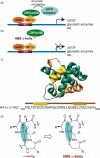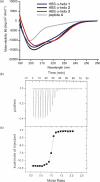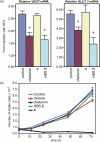Inhibition of hypoxia inducible factor 1-transcription coactivator interaction by a hydrogen bond surrogate alpha-helix
- PMID: 20041650
- PMCID: PMC2810346
- DOI: 10.1021/ja9082864
Inhibition of hypoxia inducible factor 1-transcription coactivator interaction by a hydrogen bond surrogate alpha-helix
Abstract
Designed ligands that inhibit hypoxia-inducible gene expression could offer new tools for genomic research and, potentially, drug discovery efforts for the treatment of neovascularization in cancers. We report a stabilized alpha-helix designed to target the binding interface between the C-terminal transactivation domain (C-TAD) of hypoxia-inducible factor 1alpha (HIF-1alpha) and cysteine-histidine rich region (CH1) of transcriptional coactivator CBP/p300. The synthetic helix disrupts the structure and function of this complex, resulting in a rapid downregulation of two hypoxia-inducible genes (VEGF and GLUT1) in cell culture.
Figures



Similar articles
-
Inhibition of hypoxia-inducible transcription factor complex with designed epipolythiodiketopiperazine.Biopolymers. 2011 Jan;95(1):8-16. doi: 10.1002/bip.21550. Biopolymers. 2011. PMID: 20882602
-
Structural basis for negative regulation of hypoxia-inducible factor-1alpha by CITED2.Nat Struct Biol. 2003 Jul;10(7):504-12. doi: 10.1038/nsb936. Nat Struct Biol. 2003. PMID: 12778114
-
Functional analysis of hypoxia-inducible factor-1 alpha-mediated transactivation. Identification of amino acid residues critical for transcriptional activation and/or interaction with CREB-binding protein.J Biol Chem. 2002 Oct 11;277(41):38723-30. doi: 10.1074/jbc.M205051200. Epub 2002 Jul 19. J Biol Chem. 2002. PMID: 12133832
-
Recent Advances in the Discovery of HIF-1α-p300/CBP Inhibitors as Anti-Cancer Agents.Mini Rev Med Chem. 2018;18(4):296-309. doi: 10.2174/1389557516666160630124938. Mini Rev Med Chem. 2018. PMID: 27484627 Review.
-
Hypoxia-inducible factor-1 (HIF-1).Mol Pharmacol. 2006 Nov;70(5):1469-80. doi: 10.1124/mol.106.027029. Epub 2006 Aug 3. Mol Pharmacol. 2006. PMID: 16887934 Review.
Cited by
-
Serverification of molecular modeling applications: the Rosetta Online Server that Includes Everyone (ROSIE).PLoS One. 2013 May 22;8(5):e63906. doi: 10.1371/journal.pone.0063906. Print 2013. PLoS One. 2013. PMID: 23717507 Free PMC article.
-
Structural and pharmacological effects of ring-closing metathesis in peptides.Molecules. 2010 Sep 21;15(9):6638-77. doi: 10.3390/molecules15096638. Molecules. 2010. PMID: 20877250 Free PMC article. Review.
-
Structural basis for cyclic Py-Im polyamide allosteric inhibition of nuclear receptor binding.J Am Chem Soc. 2010 Oct 20;132(41):14521-9. doi: 10.1021/ja105068b. J Am Chem Soc. 2010. PMID: 20812704 Free PMC article.
-
Advances in targeting 'undruggable' transcription factors with small molecules.Nat Rev Drug Discov. 2021 Sep;20(9):669-688. doi: 10.1038/s41573-021-00199-0. Epub 2021 May 18. Nat Rev Drug Discov. 2021. PMID: 34006959 Review.
-
Getting in shape: controlling peptide bioactivity and bioavailability using conformational constraints.ACS Chem Biol. 2013 Mar 15;8(3):488-499. doi: 10.1021/cb300515u. Epub 2012 Nov 30. ACS Chem Biol. 2013. PMID: 23170954 Free PMC article. Review.
References
-
- Ptashne M, Gann A. Genes and signals. Cold Spring Harbor Laboratory Press; New York: 2002.
-
- Mapp AK, Ansari AZ. ACS Chem. Biol. 2007;2:62–75. - PubMed
-
- Buhrlage SJ, Bates CA, Rowe SP, Minter AR, Brennan BB, Majmudar CY, Wemmer DE, Al-Hashimi H, Mapp AK. ACS Chem. Biol. 2009;4:335–344. - PMC - PubMed
- Becerril J, Hamilton AD. Angew. Chem. Int. Ed. 2007;46:4471–4473. - PubMed
- Liu B, Alluri PG, Yu P, Kodadek T. J. Am. Chem. Soc. 2005;127:8254–8255. - PubMed
- Shimogawa H, Kwon Y, Mao Q, Kawazoe Y, Choi Y, Asada S, Kigoshi H, Uesugi M. J. Am. Chem. Soc. 2004;126:3461–3471. - PubMed
-
- Hirota K, Semenza GL. Crit. Rev. Oncol. Hematol. 2006;59:15–26. - PubMed
-
- Semenza GL. Nat. Rev. Cancer. 2003;3:721–732. - PubMed
Publication types
MeSH terms
Substances
Grants and funding
- R21 HL094969-02/HL/NHLBI NIH HHS/United States
- R01 GM073943-04/GM/NIGMS NIH HHS/United States
- R21 HL094969-01/HL/NHLBI NIH HHS/United States
- R01 GM073943-01S1/GM/NIGMS NIH HHS/United States
- R01 GM073943-05/GM/NIGMS NIH HHS/United States
- R01 GM073943-02/GM/NIGMS NIH HHS/United States
- R01 GM073943/GM/NIGMS NIH HHS/United States
- HL094969/HL/NHLBI NIH HHS/United States
- R01 GM073943-03/GM/NIGMS NIH HHS/United States
- GM073943/GM/NIGMS NIH HHS/United States
- R21 HL094969/HL/NHLBI NIH HHS/United States
- R01 GM073943-01/GM/NIGMS NIH HHS/United States
LinkOut - more resources
Full Text Sources
Other Literature Sources
Miscellaneous

